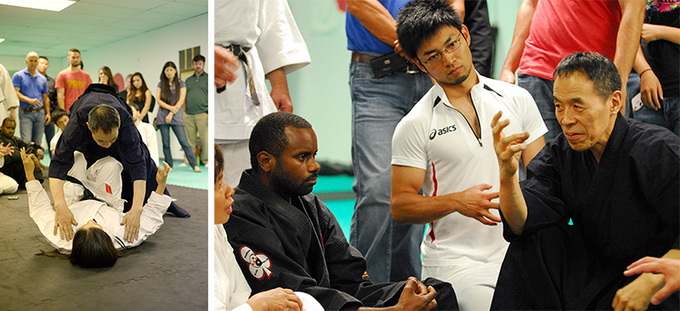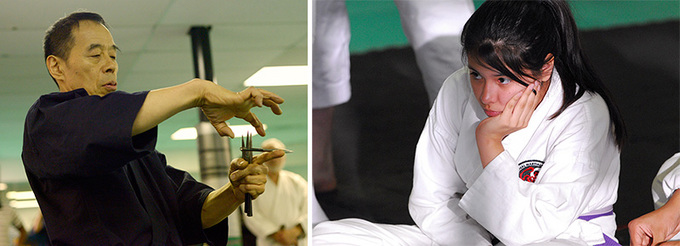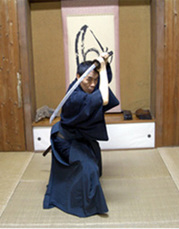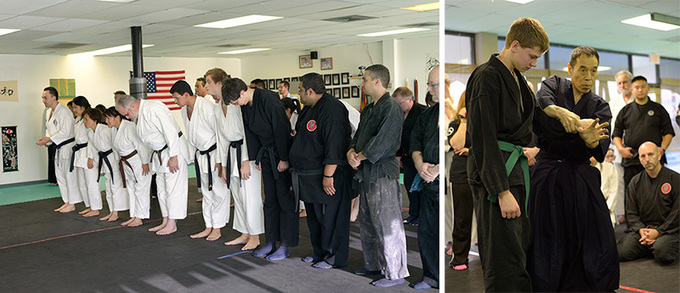An American Journey--Martial Arts Master Yoshinori Kono
Yoshinori Kono
Martial arts master and researcher
In March 2012, I received a request from Ms. Hiroko Ooka at the Japan Foundation to conduct a bujutsu (Japanese martial arts) lecture, demonstration and workshop tour in the United States. The request took me by surprise and initially I was going to decline, as the call came at extremely short notice. In the end, though, I accepted the offer, partly won over by Ms. Ooka's enthusiasm and partly because my eldest son Harunori, my regular travel companion for overseas trips, was eager to go. On May 22, I found myself with Harunori on a flight leaving Narita Airport, Tokyo, bound for Houston, Texas.
We arrived in Houston in mid-afternoon, and the airline crew reported a ground temperature of 34°C (94°F). As I caught my first glimpse of the American continent from the airplane, I was struck by how white the roads were compared to those in Japan. Later, after I came back to Japan, someone told me that an asphalt surface could not withstand Houston's searing heat, so the roads are made of concrete, hence the white color, which explained the matter.
My American journey commences in Houston
A first-time traveler to the U.S., I was astonished to see how stringent the entry procedure was at the airport. Although there were a number of gates, the lines were long, with some people taking as long as ten minutes to clear immigration. When at last it was our turn, I handed Harunori the documents I'd received from Ms. Ooka before our departure, including a letter issued by the Consulate-General of Japan in Texas testifying that they had invited us to the U.S., and a brochure for the upcoming bujutsu events--and had him explain the reason for our visit to the immigration officer. It appeared that the officer was a martial arts fan; "Sensei? (teacher)," he said, smiling at me, and shaking my hand. Then he allowed us to pass through the gate in no time. It seems that the term sensei has become fairly common in the U.S. nowadays as a term to refer to bujutsu or budo instructors. You might call it an American counterpart to Japanese-English --American-Japanese, perhaps?
The first stop on the tour was scheduled at Sharpstown International School in Houston where we were to hold a demonstration and workshop for junior high school students. A pleasant surprise awaited me at the school--there was a sign on the gate welcoming me!
During the event I was assisted by Haruo Matsuoka, who teaches Aikido in Los Angeles, and Mr. Matsuoka's student Eric de Valpine. Mr. Matsuoka was very helpful in many ways during my stay, serving as an interpreter and letting me borrow his mock sword for my lecture and demonstration.
At Sharpstown International School, I assumed that the audience--sixth to eighth graders-- would find a live demonstration and an actual practice more interesting than a lecture. So after a brief talk, I invited several volunteers to come up front and gave them hands-on instructions in some of the techniques. Seeing their peers performing, the entire audience was quickly drawn in and when I saw that this approach was working, I had the students come up one after another to give it a try. Specifically, I showed them the basics of tai-jutsu (empty hand), ken-jutsu (sword), and jo-jutsu (soft or gentle). The school principal, a Korean-American, also tried out some of the techniques, and as I watched his humorous facial expressions and movements during the exercise, I thought to myself, "This is America, indeed."
After the session at the school we moved on to our next appointment, at one of Houston's karate dojo, International Martial Arts Karate Houston. Here, I conducted a workshop for American bujutsu enthusiasts. The audience was keenly interested, much more so than I had anticipated, and I became so engrossed that I lost track of time.

Some 150 middle school students attended the lecture and workshop at Sharpstown International School in Houston. The session was a great success, with many students volunteering to practice several different styles of bujutsu, such as the basics of tai-jutsu, ken-jutsu, and jo-jutsu. In ken-jutsu the students learned how differently the sword would begin to move when it was gripped with two hands close together and when gripped with a distance between the two hands.
Shuriken demonstration at a karate dojo
The next day, the Japanese Consul-General in Houston, Mr. Jota Yamamoto, invited us to dine at a Mexican restaurant. Having been detained by other business, Mr. Yamamoto arrived a little late, but listened with deep interest as I talked about the Japanese craftsmen who make our equipment, and it was a great pleasure for me to share these stories with my host.
Afterwards, we were off to the same karate dojo where we had held a workshop the day before. By the second day, several faces had become familiar. Just as on the previous day, before closing the session I did a shuriken (a bladed throwing weapon) demonstration with a big plaster board prepared by the dojo as a target.
There are several different schools of shuriken, and the weapon comes in many different shapes and designs. I use the Harigata (needle-shaped) shuriken which is a type of Negishi ryu blade. They are octagonal, straight-sided and shaped like a missile. Using the chokudaho or the direct hit method, these blades are thrown without rotating for more than a quarter of a turn to hit targets anywhere from 1.8 to 9.09 meters away.
Shuriken is a well-known weapon, but most people, including Japanese, seem to associate the term with the star-shaped kurumaken, which are made from flat plates of metal, rather than with straight metal spikes like the Harigata shuriken. I suspect that only a tiny fraction of Japanese are even aware that shuriken-jutsu is one of the disciplines that comprise the martial arts.
That being the case, I was not the least bit surprised when the Italian Consul-General at Houston--a karate practitioner who attended the workshop--remarked, "I have always thought shuriken was something from the Hollywood movies and not a formal style of art." No doubt many people were under the same impression. So I illustrated the great amount of skill required in throwing a shuriken by explaining that, unlike archery arrows, you need to adjust the way you throw the blade depending on your distance from the object aimed at; if not tossed properly the shuriken won't even stick in the target. Of all the disciplines of traditional bujutsu, the level of difficulty is most clearly evident in shuriken-jutsu.

Budo practitioners dressed in martial arts uniforms greeted Kono at International Martial Arts Karate Houston, where he held a two-day workshop for about 40 participants. Workshops for budo enthusiasts and experienced students were held in Nashville and Minneapolis in addition to Houston, and the master answered a host of questions from the participants during the events.

(Left) The demonstration using the needle-shaped, octagonal blade helped to alter the stereotypical perception of shuriken which is often associated only with the star-shaped kurumaken. Kono explained that no other discipline requires as difficult a technique as the shuriken-jutsu.
(Right) A female budo practitioner watches intently as the master demonstrates a technique.
Japanese singer Kana Uemura joined the workshop in Nashville
Following Houston we visited Nashville, Tennessee, where I was awestruck by the beautiful landscape. The state of Tennessee reminded me of the American pioneer hero Davy Crockett in the adventure film Davy Crockett, King of the Wild Frontier, which I watched when I was a child.
To my pleasure the Japanese singer Kana Uemura joined us for the workshop in Nashville. Uemura is known for the unusual song Toire no kamisama ( A god in the toilet) that became such a huge hit in 2010 it landed her a place in the Kohaku Uta Gassen, an annual music show on New Year's Eve. She was reportedly due to leave Nashville earlier that day but had postponed her departure to take part in the evening session, in which she was a particularly energetic participant.
In Nashville, I was amazed at how the hotel rooms were set up with such care and attention to detail. Plenty of people had warned me that in general, the levels of service in America are not as high as they are in Japan, but I was impressed by the hotel's efforts to ensure our comfort with the kind of care that you rarely see even in Japan. For instance, the towel in the bathroom was folded elegantly like a flower, with a smaller towel placed inside it. Also, the shower curtain was transparent at the top so the guest could see through it while showering, making the small bathtub space feel more open. Yet another surprise--and this was not just in Nashville but in all the hotels I stayed at in America--was that the soap's fragrance was lighter compared to what you would find in Japan, which I appreciated. Another thing I liked about the American hotels was that there were many more power outlets in the guest room than there are in Japanese hotel rooms, which was very convenient.
From Tennessee to Kentucky, then to Minnesota
After a day in Nashville, we headed for our next destination, Louisville, Kentucky. The lecture and demonstration at Frazier History Museum attracted the largest audience of all my events in America. After the lecture, I was approached by a Japanese man named Mr. Sato, a resident of Louisville who trains in karate. He asked me some questions, and then we talked a little and practiced some techniques. He astonished me by telling me that he was a Christian minister, but more importantly, he gave me a poignant reminder of the enormous power of faith. I say this is because his warm and pleasant words and actions, doubtlessly a reflection of his faith, left a lasting impression on me. Meeting people like this is definitely one of the great pleasures of traveling.
We concluded our tour in Minneapolis, where I held the last lecture and demonstration session. I was delighted to meet many avid martial arts fans in this city as well. I was especially thrilled when an American gentleman who runs the Kaishin Dojo, a kenjutsu school in Minneapolis, loaned me a genuine Nihonto (sword) produced many years ago by a Japanese swordsmith to use in my demonstration.
In kenjutsu, the sword is generally grasped at the handle leaving the width of a fist between the right and the left hand. As I demonstrated, however, I held the sword with my hands pressed together. Watching my lecture and demonstration, the enthusiastic participants came to appreciate the effectiveness of this style of grip, which is unfamiliar even for most Japanese budo practitioners. In fact, they liked it so much that someone asked me, "How can I get my Iaido instructor to accept Kono Sensei's grip style?" to which I could only respond with a puzzled smile.
At the end of the trip--thinking anew about one's country
While in America, we visited five cities over ten days and held eight sessions of lectures, demonstrations, and workshops. It was a busy schedule, but the trip taught me a number of things.
Globalization, for better or worse, is an inescapable reality of our times and the unique cultural identities and characteristics of each ethnic group will increasingly lose their distinctiveness. It is also true, nevertheless, that the more globalized the world becomes, the stronger people's love for their own country grows. This trip convinced me of that, especially when I saw the interest in Japan expressed by Japanese students who were studying in the U.S., and who assisted me in many ways during my stay in Minneapolis. It seems that the significance of the nation-state itself will be influenced by how the stance of people to their own culture plays out.
When you try to define what your country is, you realize that you cannot discuss your country without discussing its culture. It was this trip to America that inspired me to give this subject serious thought. If the opportunity presents itself, I would like to travel abroad again.
 Yoshinori Kono
Yoshinori Kono
Born in Tokyo in 1949, Yoshinori Kono is a Japanese martial arts master and researcher. He launched Shouseikan Dojo in 1978, and has dedicated himself to research and development of a unique style of martial arts. His research has been utilized effectively in various fields such as sports, performance of musical instruments, engineering, and nursing care. In 2003, he was the subject of an eight-part series in the Ningen Koza (Humanity Lectures) series on NHK's educational channel. Kono was a visiting professor at Kobe College for three years from 2007.
Presently, he mainly lectures and conducts seminars and workshops on bujutsu across Japan. He has authored many books, including Ken no seishinshi (The Spritual History of Swordsmanship) (Chikumashobo); Budo kara bujutsu e (From Budo to Bujutsu) (Gakken Publishing); Jibun no atama to karada de kangaeru (Thinking with Your Own Mind and Body) (Co-authored with Takeshi Yoro, PHP Institute); and Karada o toshite jidai o yomu (Reading the Times Through Your Body) (Co-authored with Tatsuru Uchida, basilico; paperback: Bungeishunju).
Lecture, demonstration and workshop tour in the United States featuring Yoshinori Kono: Schedule
Houston, Texas
Wednesday, May 23, 2012
Lecture and demonstration for middle school students
Venue: Sharpstown International School
Workshop for budo practitioners/individuals with an interest in budo
Venue: International Martial Arts Karate Houston
Thursday, May 24, 2012
Workshop for budo practitioners/individuals with an interest in budo
Venue: International Martial Arts Karate Houston
Nashville, Tennessee
Friday, May 25, 2012
Workshop for budo practitioners/individuals with an interest in budo
Venue: School of Dance Music
Louisville, Kentucky
Saturday, May 26, 2012
Lecture and demonstration for the general public
Venue: Frazier History Museum
Minneapolis, Minnesota
Monday, May 28, 2012
Lecture and demonstration for the general public
Venue: University of Minnesota
Workshop for budo practitioners/individuals with an interest in budo
Venue: University of Minnesota
Tuesday, May 29, 2012
Workshop for budo practitioners/individuals with an interest in budo
Venue: University of Minnesota
Chicago, Illinois
Wednesday, May 30, 2012
<Unofficial visit> Kendo dojo in Chicago
Back Issues
- 2024.11. 1 Placed together, we …
- 2024.5.24 The 50th Japan Found…
- 2024.5.24 The 50th Japan Found…
- 2024.2.19 Movie Theaters aroun…
- 2024.2.19 Movie Theaters aroun…
- 2023.4.24 The 49th Japan Found…
- 2022.10.24 Inner Diversity <2> …
- 2022.10. 5 Living Together with…
- 2022.6.13 The 48th Japan Found…
- 2022.6. 3 The 48th Japan Found…



